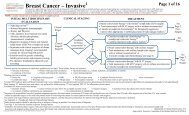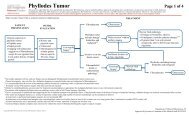MEDICINE
1YkigAQ
1YkigAQ
You also want an ePaper? Increase the reach of your titles
YUMPU automatically turns print PDFs into web optimized ePapers that Google loves.
About Us<br />
From following her father’s footsteps to international thought leader<br />
Shpall continues to blaze trails in transplantation<br />
application of this technique in mice worked so well that she moved<br />
on to the first-in-man trial of cord blood cell fucosylation. It worked.<br />
“It’s one of the coolest things,” she said of this breakthrough. She has<br />
authored and co-authored hundreds of research abstracts, articles,<br />
and editorials, and her 2015 manuscript, “Enforced fucosylation of<br />
cord blood hematopoietic cells accelerates neutrophil and platelet<br />
engraftment after transplantation,” was selected by Blood journal<br />
editors as one of the top 10 most impactful manuscripts of the year<br />
[2015;125(19):2885−92]. She also was one of the inaugural recipients of a<br />
new award, the R. Lee Clark Prize, an honor given to faculty members<br />
who exemplify the spirit of MD Anderson’s first president.<br />
Elizabeth Shpall, MD<br />
Shpall, left, with MD Anderson President Ron DePinho, MD, and Champlin<br />
at the 2013 ribbon-cutting ceremony for the opening of the Cord Blood Bank.<br />
As a young girl, Dr. Elizabeth Shpall would accompany her<br />
father while he performed hospital rounds on weekends.<br />
He was a family practice internist who did everything including delivering<br />
babies, and she admiringly refers to him as a great clinician. She followed in his<br />
footsteps again by going into medicine. “In the back of my mind, I always knew<br />
I wanted to be a doctor,” says Shpall, professor of Stem Cell Transplantation &<br />
Cellular Therapy (SCT/CT), medical director of the GMP Cell Therapy Laboratory,<br />
and director of MD Anderson’s Cord Blood Bank.<br />
She found research fascinating and felt compelled to make a difference on a<br />
large scale. “When I looked at all the patients with cancer, I realized there was<br />
a real need to go into oncology research,” she noted. After earning dual degrees<br />
in French and Biology from Brown University in 1976, Shpall completed her<br />
medical education at the University of Cincinnati College of Medicine in 1980.<br />
She was a resident at Beth Israel Medical Center in New York, and a fellow<br />
in the Department of Neoplastic Diseases at Mount Sinai Medical Center,<br />
also in New York, from 1983 through 1985, serving as chief fellow in her final<br />
year. While at Mount Sinai, she met her husband, Roy Jones, MD, PhD, also<br />
a professor of SCT/CT at MD Anderson, and they opened a small transplant<br />
section, which helped direct her future career trajectory. “We began to harness<br />
the donor cells, and realized they had an amazing, powerful effect that was<br />
more profound than straight chemo. I just thought it was the greatest field,”<br />
Shpall says.<br />
Before MD Anderson recruited her and Jones in 2002, she was the director of<br />
the University of Colorado Health Sciences Center cord blood bank, a program<br />
she started and ran for eight years. MD Anderson wanted to purchase the bank<br />
in Colorado when she made the move to Houston, but this plan fell through at<br />
the last minute and she started over locally with the most modern equipment.<br />
“It’s so fortunate that our bank is state of the art,” she said. (Read more about<br />
the Cord Blood Bank on page 23.)<br />
“We’re now taking the sugar and putting it on T regs and other cell<br />
types, and studying it in NK cells,” she said. “There’s a lot of areas<br />
where it could become very helpful.” For example, preliminary work is<br />
underway with CD34 cells, T cells and expanded B cells.<br />
“Dr. Shpall has made an enormous impact in the field of hematopoiesis, and<br />
transplantation of hematopoietic stem cells and umbilical cord blood,” said SCT/<br />
CT Department Chair Richard Champlin, MD. “She is clearly an international<br />
thought leader in this field, and her work has set universal standards for stem<br />
cell and cord blood transplantation.”<br />
Shpall’s landmark 2012 trial demonstrating that co-culturing cord blood cells<br />
with mesenchymal cells during ex vivo expansion significantly shortened time to<br />
neutrophil and platelet engraftment has become standard of care. Further, she<br />
is recognized for developing “purging” approaches to eliminate malignant cells<br />
from the transplant graft [New England Journal of Medicine 2012;367(24):2305−15].<br />
Shpall’s influence in the field of stem cell transplantation reaches far beyond<br />
the Texas Medical Center. She is the current vice-president of the Foundation<br />
for the Accreditation of Cellular Therapy (FACT), having chaired their Cord Blood<br />
Standards Committee since 1999. She was also the founding president and has<br />
been a board member of the Foundation for the Accreditation of Hematopoietic<br />
Cell Therapy since 1995. MD Anderson became FACT’s first accredited<br />
institution in 2000 and has earned reaccreditation four times. Internationally,<br />
she has been a member of the International Society for Cellular Therapy since<br />
1992 and participated in the International Association for Breast Cancer<br />
Research from 1992 to 2000.<br />
Shpall’s R01 grant on stem cell expansion has been continuously funded by the<br />
NCI for over 21 years, and her renewal for this grant which she now co-leads<br />
with Katy Rezvani MD, PhD, professor of SCT/CT and director of translational<br />
research, scored in the top 3% in 2015. She has received grants from CPRIT,<br />
and in collaboration with Rezvani is involved with projects in several moon shot<br />
grants including CLL (with William Wierda, MD, PhD), AML/MDS and B Cell<br />
Lymphoma (with Champlin), Myeloma (with Nina Shah, MD) and Brain Tumor<br />
(with Amy Heimberger, MD, and Fred Lang, MD). Shpall and Cassian Yee,<br />
MD, are the scientific directors of the Moon Shot Adoptive Cell Therapy (ACT)<br />
Platform. Shpall also is the principal investigator of the National Institutes<br />
of Health (NIH)-funded Program Project Grant (P01) “Improving Cord Blood<br />
Transplantation.”<br />
Division of CANCER <strong>MEDICINE</strong> 2015–16 DIVISION REPORT<br />
5<br />
Delays in engraftment have remained a major problem. Shpall found precedent<br />
in the literature for adding a sugar molecule, fucose, to cord blood cells to<br />
help them home to engraftment sites, hopefully speeding the process. Initial<br />
On the horizon are several protocols with applications in regenerative medicine<br />
using bone marrow-derived mesenchymal stem cells, some of which are funded<br />
by the Texas Medical Center. “These things are kind of exciting,” said Shpall.






